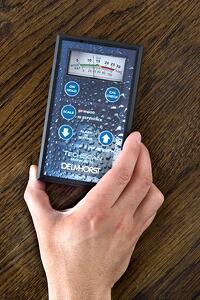When testing the moisture content of wood, there are many environmental factors that can influence the results of your moisture reading, such as:
-
The species of the wood being tested.
-
Surface moisture on the object.
-
Ambient humidity.
-
Condition of the moisture meter (dirty, damaged, or out of calibration).
In addition to these factors, there’s one more thing that can affect the %MC reading you get when measuring moisture: the temperature.
Different moisture meters will react to changes in temperature differently. So, to help you make sure you’re getting the most out of your moisture readings, we’ve assembled a few short explanations of how the temperature affects different kinds of moisture meter types.
Pin-Type Meters and Temperature
For a pin-type moisture meter, the temperature of the object being tested can have a significant impact on the %MC reading. This is because pin-type moisture meters operate on the principle of electrical resistance. When a pin meter takes a reading, it passes a small electrical current through the wood (or other building material) and measures how much resistance there is to the current. Generally speaking, the drier the wood, the more resistance there is, and the more moisture there is in the sample, the less resistance there will be.
Higher temperature can make wood and other materials slightly more conductive to electricity, meaning that pin type moisture meters might return a reading that is higher than the object’s actual %MC. Very low temperatures, on the other hand, reduce the conductivity of the wood slightly, somewhat lowering the moisture content reading given by a pin meter.
In the case of Delmhorst pin-type meters, temperatures between 50 and 90 degrees Fahrenheit (10 and 32.2 degrees Celsius) should not cause any significant changes in the %MC reading of wood, as these meters are calibrated at 70 degrees Fahrenheit.
Pinless Meters and Temperature
 For pinless meters, the temperature of the wood or other object being measured is, at worst, a minimal concern. This is because pinless moisture meters don’t rely on electrical resistance to get a reading of the moisture in the object being tested. Instead, these meters use electromagnetic waves to measure moisture content in an object.
For pinless meters, the temperature of the wood or other object being measured is, at worst, a minimal concern. This is because pinless moisture meters don’t rely on electrical resistance to get a reading of the moisture in the object being tested. Instead, these meters use electromagnetic waves to measure moisture content in an object.
Unless a given wood sample is frozen solid, the temperature of the wood should not have any significant impact on the moisture reading. Rather, surface moisture from condensation will be the true obstacle for very cold objects.
How Temperature Impacts Wood
Of course, when a sample of wood sits in a hot or cold environment, its actual moisture content may also change. Wood is a hygroscopic material, meaning that it will absorb or bleed moisture from itself until it reaches an equilibrium with its surrounding environment.
For example, in warmer environments, water evaporates and, unless the environment is sealed, the majority of the vaporized moisture leaves. This makes the area drier, and the wood will bleed moisture until it reaches equilibrium, making it drier.
In colder environments, moisture in the air tends to settle, collecting on surfaces in a process known as condensation. Since moisture is not vaporizing, but instead being collected on the surface of the wood, the wood becomes damp, increasing its moisture content.
Because of this, it may be important to give a sample of wood time to acclimatize before measuring its %MC, or to check again later if the room in question experiences a sharp, sudden change in temperature.
By taking the temperature of the object being measured into account, you can make sure that your moisture content readings are as accurate as possible.
Learn more about moisture meters in the Moisture Meters 101 Guide from Delmhorst!
Comments